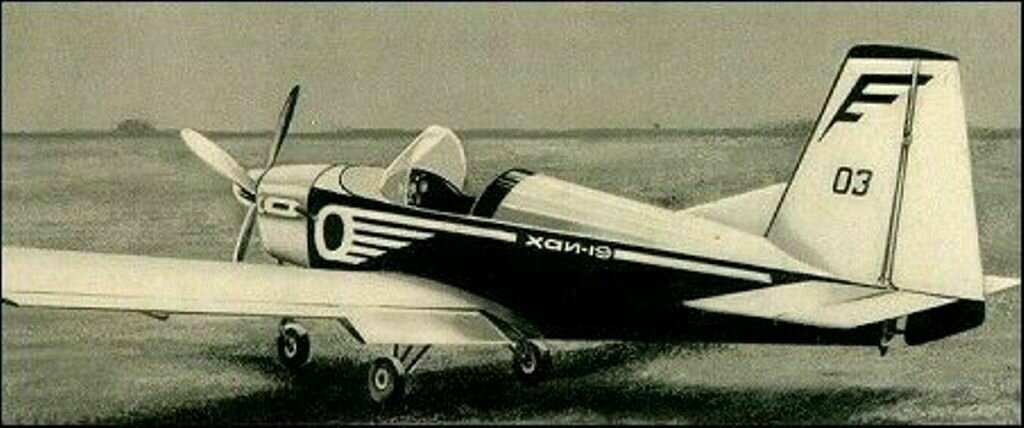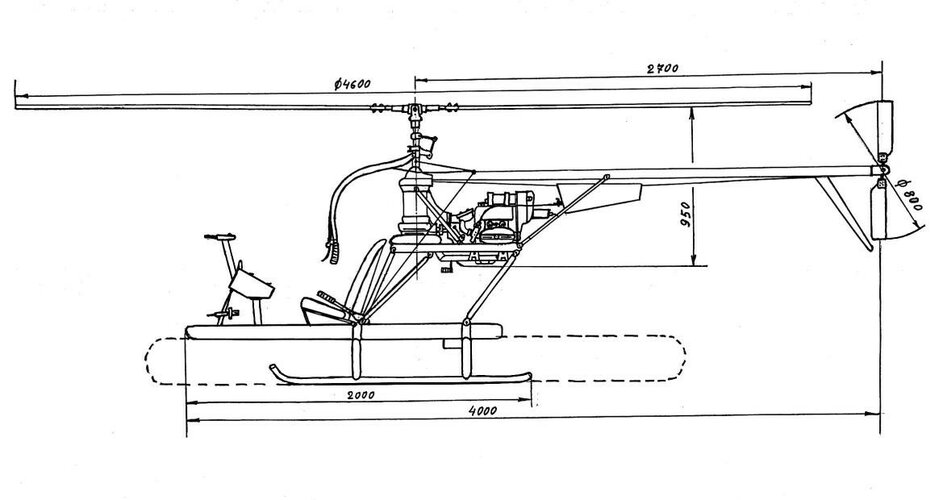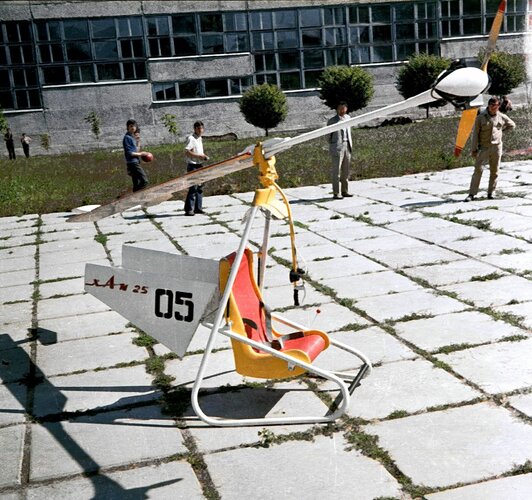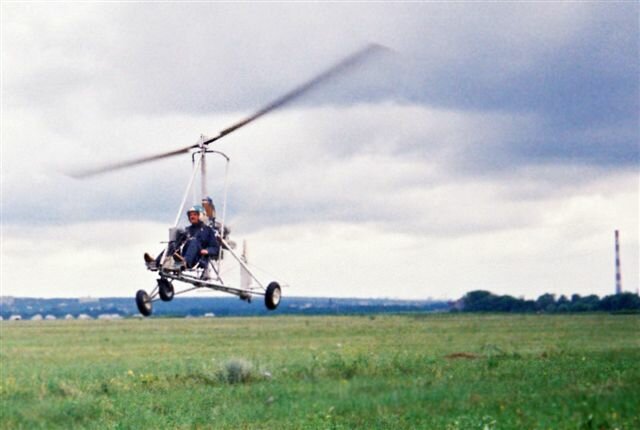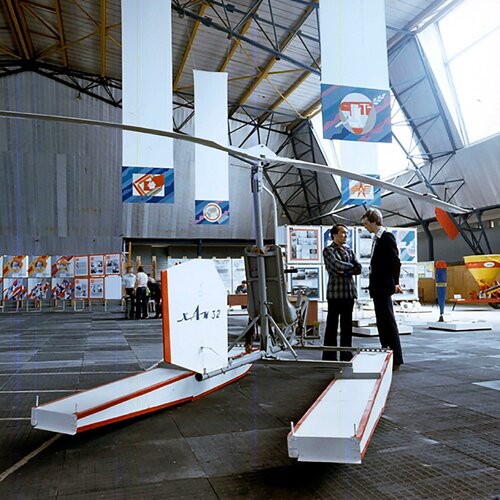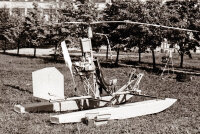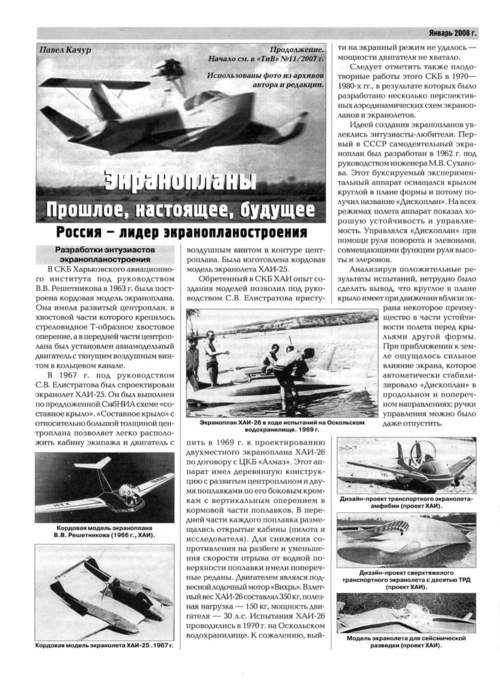KhAI-27 Kharkovyanin helicopter
It was a two-seat multipurpose liaison, observation helicopter and, when equipped with floating landing gear, it could also be used in a commercial finding of shoals of fish. KhAI-27 was designed and built between 1969 and 1970 by the members of helicopter scientific research group of KhAI (Kharkiv Aviation Institute {ХАИ}). Some of its components were built in the airplane factory in Smolensk city. The chief designer was Mr B. I. Mysov, who was supervised by V. K. Zolotukhin. The design team consisted of students: E. D. Bytensky, V. N. Glushkov, V. S. Ishchuk, I. V. Kolosova, V. S. Mishchenko, V. V. Pleshivtsev, A. P. Opara and others.
The most characteristic structural element of the KhAI-27 helicopter was a floor panel made of aircraft grade aluminum. It was constructed of stringers and end frames which were covered with 1mm thick sheet metal (riveted to panel internal elements). Edges of this panel were reinforced by riveted extra corner stiffeners. All flight controls and electrical harnesses were put inside that element. On top of the panel, two seats, instrument panel and rudder pedals were installed. The main landing gear of skid-type was made of steel tubes of 40×2 of cross-section dimensions. That landing gear was secured to the panel on its bottom side. The main structural element was a subframe which carried all main transmission and powerplant components. It was made of 30HGSA tubing and had 4 rubber engine mounts and 10 eye fittings for mounting struts. It also had a plate, located in its front part, to which a main gearbox and rotor pylon was bolted with the use of special bolts. In the upper part of the rotor column, the tail rotor shaft had its output.
The main rotor pylon was equipped with mechanisms for controlling cyclic and collective blades pitch angles. A unique one was that for controlling collective blades pitch angle. It was actuated by a nut turning on a power screw. The nut had an outer shape similar to one known from Bell 47 or Alouette 2 tail rotor pitch change mechanisms on the tail rotor gearbox. It was a kind of helical pulley which was driven by the control cable. The cable ends were connected to the collective lever. The power screw was concentric with the main rotor shaft. Cyclic pitch angle change was controlled by an ordinary swash-plate. It was mounted on an universal joint (being lifted by a power screw) and controlled by a hanging cyclic stick connected directly to a lower (inner) non-rotating swashplate ring. The rotating ring was mounted to the non-rotating ring on a ball bearing. On the cyclic stick was a lever controlling the engine's clutch.
Main rotor blades were made of fiberglass. They had rectangular planform, without geometrical twist and airfoil used was a NACA 23012. The chord length was equal to 200 mm. Blade fittings were made of welded steel elements and were secured to the fiberglass blade's root by means of hollow rivets.
The tail boom was made of a riveted sheet-metal aircraft grade aluminum. Inside there were five supports for the tail rotor shaft. At the end of the tail boom was installed a tail skid with rubber end. Tail boom was supported by two struts going from the sub-frame.
The tail rotor was a two-bladed design with a pitch change mechanism actuated by control cables connected to the rudder pedals. Blades had rectangular planform without geometrical twist. They were made of wood with NACA 0012 airfoil. The powerplant of KhAI-27 consisted of a boosted M-63F motorcycle engine. The oil systems of the engine and main rotor gearbox were connected. Thanks to the modular construction of the helicopter it was easy to be quickly folded and unfolded, which was a required feature regarding its multipurpose use.
Technical and performance data:
Length – 4.0 m,
Height – 1.7 m,
Width – 1.5 m,
Main rotor diameter – 4.6 m,
Tail rotor diameter – 0.8 m,
Engine power – 38 HP,
Empty weight – 145 kg,
Maximum take-off weight – 300 kg,
Maximum speed – 90 km/h,
Cruising speed – 70 km/h,
Descent rate in autorotation – 5.5 m/s,
Service ceiling – 2000 m,
Range – 200 km.
The prototype of KhAI-27 had been tested in the tethered flight. During these tests the lifting system, structure and components have been tested. Although the M-63F engine was boosted by IMZ-Ural motorcycle factory, it was not delivering required power and the KhAI-27 had never been flown freely. The helicopter was exhibited at the ENEA USSR {ВДНХ CCCP} exhibition in 1970, where its designers were awarded with diplomas of honor and gold, silver and bronze ENEA medals.



